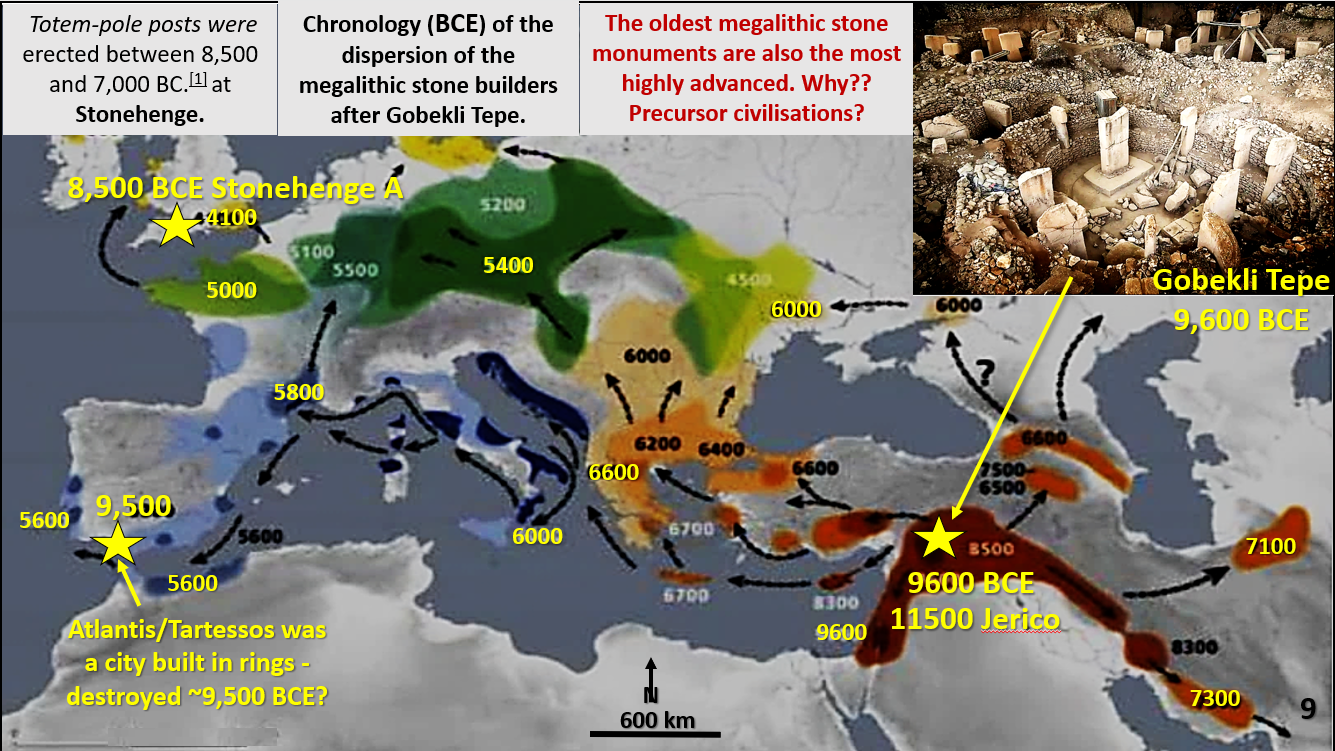Figure 9 above. Chronology of the dispersion of the megalithic stone builders after Gobeklitepe
These papers are an expansion of my AusIMM webinar https://www.ausimm.com/videos/community-event/south-west-wa-branchgeoscience-society—digital-tech-talk-geo-archaeology-correlation-between-civilisation–mining/
I believe only the 13,000 AusIMM members can currently access this video.
The premise of my research is that it should be available free to all those interested. I aim to make it available to all! Discussions with AusIMM are ongoing 🙂 .
When I studied ancient history back in the late 1960s the Mesopotamian civilisation was considered the oldest civilisation on earth at 4,500 BCE. We are now looking at double that time period.
There have been many new discoveries of ancient civilisations in the last 50 years but the most remarkable of these was discovered about 25 years ago in the Harran Plain, Gobeklitepe area in Turkey. Gobeklitepe has been dated at about 9,500 BCE and is an absolutely amazing site! https://en.wikipedia.org/wiki/G%C3%B6bekli_Tepe .
It is a concentric, circular Stonehenge type construction about 7,500 years older than Stonehenge! It is also is much more complicated and advanced in its construction, science, religion and decoration than Stonehenge.
How extensive was the spread of the Harran Plain culture.
I use the term Harran Plain for the Gobeklitepe area as this was the area around which the large, 200 km X 200 km Gobeklitepe era civilisation was centered. It has been in continuous, urbanised civilisation from 10,000 BCE to the present.
This short video chronicles the Spread of Civilisation around the Earth from 10,000 BCE to today. Play it a couple of times to see that the Harran Plain – Jericho area is the currently recognised starting point. Stop and click to see civilisation’s spread at various times. Most interesting! Especially the Americas. The devastating impact of the (mainly) diseases brought by the Europeans between 1600 and 1700 BP is graphically shown 🙁 https://www.calacademy.org/educators/how-did-human-civilization-spread . Australia would have a similar devastating picture between 1788 and 1970!!
There has been an abundance of hypotheses about Gobeklitepe’s role in the progress of civilisation one of which is on this link. https://www.worldwidewaves.co/blog/2021/3/18/the-story-and-consequence-of-gbekli-tepe. It was published in 2021 and comes to many of the same conclusions I come to. There are differences however; copper mining as the cause of the civilisation is not mentioned and extraterrestrial impacts are supposed to have caused the sudden sea level rise. I believe it was global warming, without man’s aid and no impacts :). That’s a change for me!
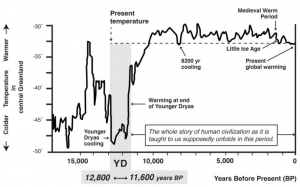
This is a figure from this paper showing the correlation of temperature in Greenland ice core with the rise of civilisation. There is a direct, but delayed, correlation with temperature and sea-level. Periods of more settled expansion of civilisation are in the warm periods (good crops over bigger areas) and collapse of civilisations in the cool periods (famine). It’s a fact, look them up for yourselves on this chart and ancient history texts!
One example of global cooling is the little ice age that caused the collapse of the three biggest empires; the Roman Empire, the splitting up of China and the invasion of India by the outside Huns, largely because of failed crops and subsequent plagues.
One example of global warming that caused the flowering of civilisation is the warm period from 700 – 1400 BP. Grapes were grown in Britain, the Vikings settled Greenland in 982 and abandoned it in 1500 BP. Civilisation in Europe flourished during this period.
We should, on the basis of civilisation’s history, be welcoming Global Warming 🙂 🙂
A statement in this paper on Gobeklitepe summarises my research methodology.
…… attempting to piece together the story of mankind—a task that requires one to detach themselves from the dogma of our current academic landscape and not be afraid of saying something wrong. The most important work being done in science is always what’s on the cusp of what is known and what is not known, requiring trial and error and the exploration of out-of-the box ideas.
Back to the spread of Civilisation!
This earliest culture spread east to India where it reached Iran in about 7,100 BCE and across Europe to England where it reached Stonehenge at about 4,100 BC. https://newsinseconds.com/thirteen-aligned-neolithic-menhirs-discovered-in-a-small-swiss-town/
However, near Stonehenge there were large holes in which timber posts, believed to have been totem poles, were erected between 8,500 and 7,000 BCE. https://www.english-heritage.org.uk/visit/places/stonehenge/history-and-stories/history/
This suggests that the advanced civilisation spread very quickly right across Europe and South Western Asia. What caused this explosive spread? Was it farming?
I suggest it was copper metal mining. The spatial evidence (Part 2, figure 6) indicates that the precursor, flooded civilisation was a copper mining one and that, when they moved upwards as the sea level rose, they took their copper mining and technological prowess with them.
Of interest is the myth of Atlantis which was a city built in rings and flooded around 9,500 BCE. This is almost the same time as Gobeklitepe was built. https://en.wikipedia.org/wiki/Atlantis and https://atlantipedia.ie/samples/tag/richard-freund/
The Cadiz/Seville area of Spain, where most people think Atlantis was situated, is the location the Egyptians ascribed to it. I did a short research paper trying to find rings in the Cadiz area to define structural geology on which Atlantis might have been built.
The rings of the city were too big to be man-made but the Atlanteans may have utilised natural geographical features. There were ring structures of the right dimensions that the Atlanteans could have built on. See link to Atlantis paper, https://www.geotreks.com.au/work/giant-ring-structures/atlantis-geology/
Of more importance to civilisation are the large, rich, ancient Las Cruces and Rio Tinto copper mines right next to the area where Atlantis was allegedly situated.
A bit of background Atlantis research;
in Plato’s times, legends regarding lost civilizations and the time of the “divine” birth of Egypt were somewhat widespread among literate Athenians. The thesis supported in the present article is that Atlantis was the name given by Plato to the land where the god-founders of Egypt originated. https://www.google.com/search?client=firefox-b-d&q=atlantis+egypt+connection
The Egyptians, at the time considered the oldest people in the world,4 themselves provided further support to the myth of a vanished ancient civilization. Their chronologies reported that their first pharaohs had been gods [5] (p.18) who came from the West, a polite way of saying that their kingdom had begun when foreign conquerors with “magical powers” (i.e., unseen technologies) arrived in the area, bringing agriculture and new knowledge. https://www.mdpi.com/2571-9408/2/1/18/htm
The above link is to a very good detailed 2019 short paper on the Atlantis/Egypt connection. It describes the climate change responsible for the flooding and gives the source of the actual lists of the annual records of the flooding of the Nile and the corresponding list of kings at the time. These extend back to the time of Atlantis 9,000 years before 600 BCE. It is a good, balanced source of background information. A must read!! https://www.mdpi.com/2571-9408/2/1/18/htm
These records of Atlantis were held by the Egyptians and retold to the Greeks about 600 BCE and they were very specific about the time that Atlantis flooded. There are still fragments of these record remaining – enough to verify the timeline.
Below is another extract from the paper;
The time of Gobeklitepe (9,600 BCE) is almost exactly the time when the monoliths in the Mediterranean were flooded (Part 2 figures 6 and 7 https://www.geotreks.com.au/life/history/who-were-earliest-european-south-west-asian-ancestors-part-2-copper-mining-kickstarting-civilisation/ ).
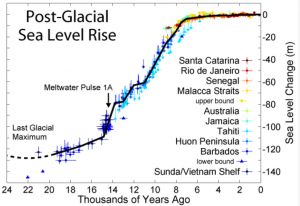
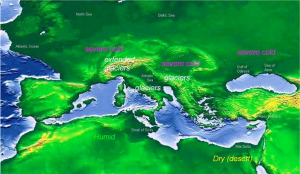
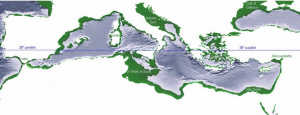
This shows the sea-level (-120metres) at about 14,000 BCE. Note the huge areas of plains that were flooded very quickly.
At 9,500 BCE Gobeklitepe was founded during a speedy sea-level rise from 60 metres below current level. This rise was after a couple of hiatuses where civilisation may have had a chance of commencing. the sea-level rose an average 2 metres per century from 12,000 – 6,000) BCE. And we think we’ve got problems??
This was around the time the Harran Plain (Gobeklitepe) civilisation started. This whole scenario lends a lot of credence to the Egyptians’ story of Atlantis.
The most technically advanced people would have fled to the highest ground within reach of the sea. They may have even built pyramidal mounds beneath their temples as further protection. Gobeklitepe is built on a man-made pyramidal mound! They would also need copper mines nearby if my hypothesis is correct. We will find out!
The next post will research the ethnicity and appearance of the people in the Harran Plain area!
Follow these posts and share them!
Happy civilising!
Bob Watchorn

